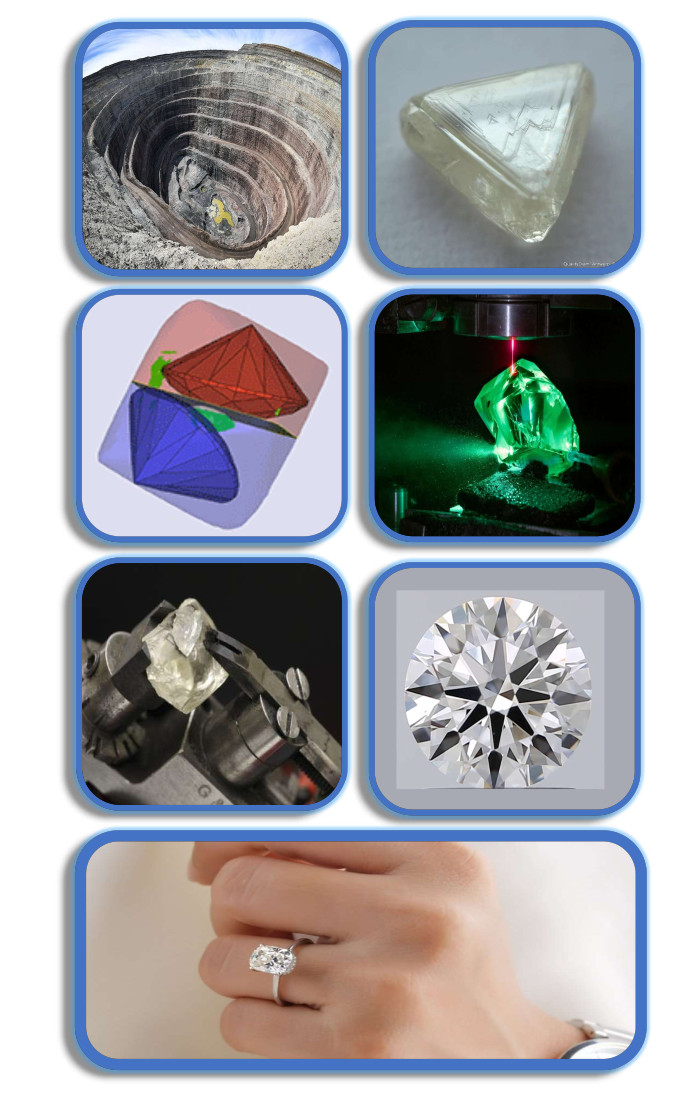About Earth Mined Diamonds
A natural diamond is a precious gemstone that forms deep within the Earth's mantle under high pressure and temperature conditions. Diamonds are composed of carbon atoms arranged in a crystal lattice structure, which gives them their unique and brilliant physical properties, including exceptional hardness and excellent refractive properties that make them sparkle.
Formation: Natural diamonds are formed from carbon atoms that have been subjected to immense heat and pressure, typically at depths of 140 to 190 kilometres (87 to 118 miles) beneath the Earth's surface. Over millions of years, carbon atoms bond together to create diamond crystals.
Mining: Diamonds are mined from kimberlite pipes and alluvial deposits. The mining process can involve extracting diamond-bearing rock from deep underground or sifting through riverbed sediments to find loose diamonds.
Characteristics: Natural diamonds come in a variety of colours, with white or colourless diamonds being the most well-known. Diamonds can also exhibit colours such as yellow, brown, blue, green, pink, and more. The presence of certain impurities or structural defects can influence a diamond's colour.
Grading: Natural diamonds are evaluated based on the "Four Cs": carat weight, cut, colour, and clarity. These factors determine a diamond's quality and value. The Gemmological Institute of America (GIA) & International Gemmological institute (IGI) are the most reputable organizations for diamond grading.
Uses: Diamonds have various uses, the most common being in jewellery such as engagement rings, necklaces, and earrings. They are also used in industrial applications due to their hardness, including cutting, grinding, and drilling.
Ethical Concerns: The diamond industry has faced ethical issues related to conflict diamonds, also known as "blood diamonds," which are mined in war zones and used to finance armed conflict against governments. Various international initiatives, such as the Kimberley Process Certification Scheme, aim to combat the trade in conflict diamonds.
Natural diamonds are dearly prized for their beauty and rarity, making them a symbol of love and luxury in many cultures. Their geological origins and unique properties have fascinated scientists and enthusiasts for centuries.
Why Earth Mined Diamonds?
Symbolism and Tradition: Diamonds, especially when used in engagement rings, have long symbolized love, commitment, and luxury. The tradition of giving a diamond engagement ring dates back to the 1940s, when the De Beers company popularized the phrase "A Diamond is Forever" in a marketing campaign. The sentiment associated with that phrase has become ingrained in many cultures, representing an everlasting bond.
Rarity: The formation process of natural diamonds takes millions to billions of years. Their deep origin in the Earth and the specific conditions required for their formation make them inherently rare, especially when considering diamonds of high quality or unique colorations.
Beauty and Brilliance: Due to their unique refractive properties, diamonds have an unparalleled brilliance and sparkle when cut and polished correctly. The way a diamond reflects and refracts light creates the dazzling appearance that is highly sought after in jewellery.
Hardness: Diamonds are the hardest known natural material. This makes them durable and resistant to scratching, which is a desirable trait for jewellery that is meant to last a lifetime and beyond.
Investment and Value: Natural diamonds can hold or even appreciate in value over time. Some people purchase diamonds as a form of investment, hoping that their rarity and demand will keep their value stable or growing.
Natural Origin and Story: For some, the allure of a natural diamond is its story — the incredible journey from deep within the Earth, formed over billions of years, only to be discovered, mined, and crafted into a piece of jewellery. This narrative can add an emotional and symbolic dimension to the stone.
Ethical and Sustainable Mining: While the diamond industry has had its share of ethical concerns, notably with conflict diamonds, there has been a significant push for ethical and sustainable mining practices. Many consumers now seek out diamonds that have been sourced responsibly, ensuring that their purchase does not fund conflicts and that the environment and workers are treated with respect.
Alternative to Lab-Grown Diamonds: While lab-grown diamonds have become more prevalent and share the same physical and chemical properties as natural diamonds, some consumers still prefer the allure and authenticity of a diamond that has been formed naturally over millennia.
The value and desirability of natural diamonds lie in a combination of their physical properties, symbolism, historical significance, and the stories they carry. While the landscape of the diamond industry is evolving, especially with the rise of lab-grown alternatives, the allure of natural diamonds remains strong for many.



